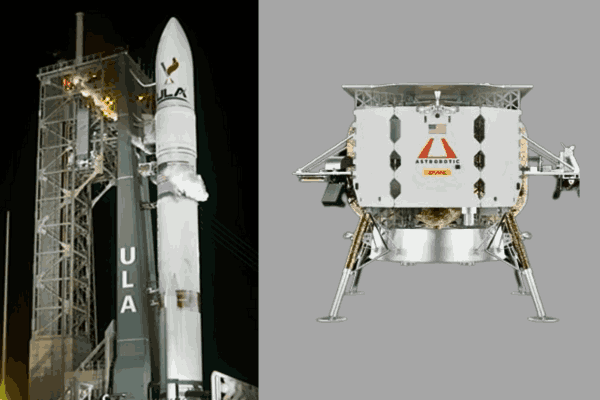NASA is poised to send its Astrobotic Peregrine Mission One on the next groundbreaking lunar exploration. January 8, is the launch date for this mission. This mission forms a major milestone in NASA’s CLPS( Commercial Lunar Payload Services ) initiative. The CLPS which is intended to unlock lunar mysteries and promote US as frontier of commercial space race.
Astrobotic Peregrine: A Lunar Odyssey Begins
CLPS Initiative Takes Flight: With the CLPS initiative of NASA which utilizes American companies’ capabilities, Astrobotic is at the forefront. The Peregrine lander is designed to launch from Cape Canaveral, Florida. It has a series of NASA payloads with the target of unraveling lunar mysteries. Astrobotics stands out as one of the chosen 14 vendors participating in this lunar exploration program. The focus is firmly on their commitment to harnessing the potential of commercial sector space exploration..
NASA’s Payloads: Unraveling Lunar Secrets
Scientific Objectives : The five NASA payloads onboard the Peregrine One from Astrobotics are intended for full lunar exploration. Such instruments such as LETS (Linear Energy Transfer Spectrometer), NIRVSS (Near-Infrared Volatile Spectroscopic System); NCS Neutron spectrometric system; PITMS Peregrine Ion-Trap Mass Specwtometer and LRA Laser Retrorreflector Array have particular uses in the study of radiation.
Landing Site – A Quest for Water : The Peregrine lander will however make a landing at the Sinus Viscositatis lunar feature outside Gruithuisen Domes. This site is of great interest because it has geological similarities to formations that require water on Earth. The mission can promise the proofs of water in Moon that is significant for future lunar efforts.
Astrobotic Peregrine: A Crucial Liftoff for Space Industry Ventures
Commercial Lunar Landers – Pioneering Space Exploration : The developers of small Pittsburgh-based company, Astrobotic’s Peregrine has the possibility to make an enormous breakthrough. If it does, then it becomes the first commercially developed spacecraft that made a soft landing on the Moon. The successful completion of this mission can have larger implications for the overall commercial space industry. This is true while companies like SpaceX are being challenged and there has been an uplifting of smaller teams in advancing space research.
Challenges and High Stakes : With Peregrine in the limelight for Astrobotics, experts in this industry are aware of the hurdles faced during lunar landings. They consider a 50/50 prospect of success.
“Astrobotics is a culmination of years of effort. However,It has been battling against skepticism and striving to motivate the commercial sector”, Astrobotic CEO John Thornton focuses on.
The mission is not only focused on the Moon as a destination. The mission also serves to define what sort of future commercial space exploration will take.
The Lunar Economy and Beyond: NASA’s Vision
Paving the Way for Humans -Artemis Program : The CLPS initiative, as envisioned by NASA beyond lunar exploration is to be a catalyst for future crewed missions under the Artemis program. Success with Peregrine may become an example for future missions. This success will help NASA achieve the goal of landing astronauts back on lunar surface sometime in this decade.
Commercial Lunar Payload Services Program : Redefining Costs: CLPS is a new paradigm for NASA: compared to Apollo-era efforts, the cost difference of lunar landers becomes radical. Astrobotic’s contract totaling $108 million marks one of the most cost-efficient approaches to lunar exploration. This begins a new chapter in space missions.
Astrobotic’s Lunar Rover –Expanding the Mission : Astrobotic’s future endeavours also include other lunar missions like a rover to the moon christened Griffin. This rover belongs to the CLPS initiative and will explore for water ice at the lunar south pole, which is a vital resource required for maintaining future lunar colonies as well as deep-space missions.
A Multinational Venture: Beyond NASA’s Sponsorship
International Collaborations -Diverse Payloads and Cultural Considerations : Astrobotic’s Peregrine is not simply with NASA payloads; it is a global collaboration. Countries such as Germany, Mexico, and the United Kingdom are collaborating with each other for lunar exploration which shows a global interest. Additionally, Peregrine will transport human remains on behalf of commercial space burial companies, raising questions about cultural sensibilities and the value of lunar real estate.
Inspiring a Lunar Economy -The Ripple Effect : This mission by Astrobotic is likely to contribute significantly towards the development of lunar economy. By participating commercial entities and smaller companies, NASA tries to develop an eye-to-eye model for future lunar exploration by combining scientific development with economic feasibility.
As such, NASA’s Astrobotic Peregrine Mission One is one of the leading forces in an emerging age of lunar exploration that combines scientific interests with commercial creativity.




